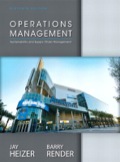
Concept explainers
National Air Express
National Air is a competitive air-express firm with offices around the country. Frank Smith, the Chattanooga, Tennessee, station manager, is preparing his quarterly budget report, which will be presented at the Southeast regional meeting next week. He is very concerned about adding capital expense to the operation when business has not increased appreciably. This has been the worst first quarter he can remember: snowstorms, earthquakes, and bitter cold. He has asked Martha Lewis, field services supervisor, to help him review the available data and offer possible solutions.
Service Methods
National Air offers door-to-door overnight air-express delivery within the U.S. Smith and Lewis manage a fleet of 24 trucks to handle freight in the Chattanooga area. Routes are assigned by area, usually delineated by zip code boundaries, major streets, or key geographical features, such as the Tennessee River. Pickups are generally handled between 3:00 P.M. and 6:00 P.M., Monday through Friday. Driver routes are a combination of regularly
When the driver arrives at each pickup location, he or she provides supplies as necessary (an envelope or box if requested) and must receive a completed air waybill for each package. Because the industry is extremely competitive, a professional, courteous driver is essential to retaining customers. Therefore, Smith has always been concerned that drivers not rush a customer to complete his or her package and paperwork.
Budget Considerations
Smith and Lewis have found that they have been unable to meet their customers' requests for a scheduled pickup on many occasions in the past quarter. Although, on average, drivers are not handling any more business, they are unable on some days to arrive at each location on time. Smith does not think he can justify increasing costs by $1, 200 per week for additional trucks and drivers while productivity (measured in shipments per truck/day) has remained flat. The company has established itself as the low-cost operator in the industry but has at the same time committed itself to offering quality service and value for its customers.
2. What, if anything, can be done to reduce the daily variability in pickup call-ins? Can the driver be expected to be at several locations at once at 5:00 P.M.?
Trending nowThis is a popular solution!

Chapter 1 Solutions
EBK OPERATIONS MANAGEMENT
- 1. Define risk management and explain its importance in a small business. 2. Describe three types of risks commonly faced by entrepreneurs. 3. Explain the purpose of a risk register. 4. List and briefly describe four risk response strategies. (5 marks) (6 marks) (4 marks) (8 marks) 5. Explain how social media can pose a risk to small businesses. (5 marks) 6. Identify and describe any four hazard-based risks. (8 marks) 7. Mention four early warning indicators that a business may be at risk. (4 marks)arrow_forwardState whether each of the following statements is TRUE or FALSE. 1. Risk management involves identifying, analysing, and mitigating risks. 2. Hazard risks include interest rate fluctuations. 3. Entrepreneurs should avoid all forms of risks. 4. SWOT analysis is a tool for risk identification. 5. Scenario building helps visualise risk responses. 6. Risk appetite defines how much risk an organisation is willing to accept. 7. Diversification is a risk reduction strategy. 8. A risk management framework must align with business goals. 9. Political risk is only relevant in unstable countries. 10. All risks can be eliminated through insurance.arrow_forward9. A hazard-based risk includes A. Political instability B. Ergonomic issues C. Market demand D. Taxation changesarrow_forward
- 8. Early warning indicators help businesses to A. Avoid legal actions B. Grow rapidly C. Detect potential risks D. Hire employees 9. A hazard-based risk includes A. Political instability B. Ergonomic issues C. Market demand D. Taxation changesarrow_forward10. Which risk category refers to taking advantage of a new opportunity despite potential challenges? A. Hazard B. Uncertainty C. Opportunity D. Strategicarrow_forward6. A business continuity plan is mainly used to_ A. Increase profits B. Handle daily tasks C. Prepare for disruptions D. Advertise services 7. What is the role of a risk owner? A. To finance the risk B. To monitor and manage a specific risk C. To create risks D. To avoid planning 8. Early warning indicators help businesses to_ A. Avoid legal actions B. Grow rapidly C. Detect potential risks D. Hire employees 9. A hazard-based risk includes_ A. Political instability B. Ergonomic issues C. Market demand D. Taxation changesarrow_forward
 Practical Management ScienceOperations ManagementISBN:9781337406659Author:WINSTON, Wayne L.Publisher:Cengage,
Practical Management ScienceOperations ManagementISBN:9781337406659Author:WINSTON, Wayne L.Publisher:Cengage, Purchasing and Supply Chain ManagementOperations ManagementISBN:9781285869681Author:Robert M. Monczka, Robert B. Handfield, Larry C. Giunipero, James L. PattersonPublisher:Cengage LearningMarketingMarketingISBN:9780357033791Author:Pride, William MPublisher:South Western Educational Publishing
Purchasing and Supply Chain ManagementOperations ManagementISBN:9781285869681Author:Robert M. Monczka, Robert B. Handfield, Larry C. Giunipero, James L. PattersonPublisher:Cengage LearningMarketingMarketingISBN:9780357033791Author:Pride, William MPublisher:South Western Educational Publishing Management, Loose-Leaf VersionManagementISBN:9781305969308Author:Richard L. DaftPublisher:South-Western College Pub
Management, Loose-Leaf VersionManagementISBN:9781305969308Author:Richard L. DaftPublisher:South-Western College Pub





